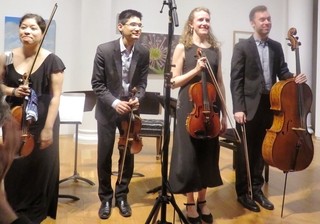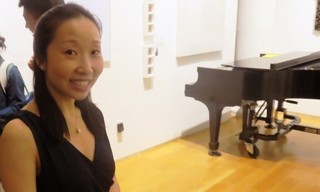|
Back
Was Beethoven a Zen Monk? New York
Tenri Cultural Center, 43 West 13th Street
09/29/2016 -
Joji Yuasa: Solitude – in Memoriam T.T.
Somei Satoh: Birds in warped time II
Toru Takemitsu: A Way a Lone
Akira Nishimura: Sonata II, “Trance Medium”
Ludwig van Beethoven: String Quartet No. 16, Op. 135
Nana Shi (Piano), Momenta String Quartet: Emilie-Anne Gendron, Alex Shiozaki (Violins), Stephanie Griffin (Viola), Michael Haas (Cello), Alex Shiozaki (Curator)

Momenta at Tenri (© Samuel A. Dog)
Like last year’s Momenta Festival at Tenri Cultural Center, the Momenta is embracing the most syncretic themes–mystical, poetic, semantic and of course musical–with each of the four players curating one evening each. This second concert was supposedly “Water” from “fire, water, earth, air”. But it was also called “An Interval of Infinity”. And it also (whew!) was a celebration of the Japanese word Ma, which could be “gap” or “space-time” or (said annotator/violinist Alex Shiozaki) “The natural pause or interval between two or more phenomena occurring continuously.”
Which means that we’d better head to the music. Music from 20th Century Japan and 19th Century Beethoven. And the Momenta Quartet itself, four players not only technically adept but who had an ease with each other. Whether playing alone or in ensemble, one feels that the individual personalities are neither subdued nor aggressive.
Individually they may sparkle, and as an ensemble, their lightness of touch allows them to ration their emotional intensity.
Actually, the entire Momenta group was together for one major work, the final quartet of Beethoven. Mr. Shiozaki’s program notes–rare notes indeed, philosophically and educationally–gave Beethoven the Zen treatment, accenting “the unusual role of silence” in this F Major Quartet.
Perhaps it was an orphic silence, more likely the silence of a man at peace with himself. And this was so well translated by the Momenta group. As a group, they tied all four movements together. We didn’t need Beethoven’s cryptic question in the last movement. That could have been an inner joke. Instead, the Momenta could have been playing Dvorák, with a serenity, a songfulness, a softness.
Yet we had our solo moments as well. First violinist Emilie-Anne Gendron gave a romantic, never cloying sweetness in the third movement. As if to say that Beethoven’s serenity was inspired by human emotions. And in the finale, cellist Michael Haas played that folk song not as Beethoven but a simple song of adoration. Adoration repeated by the full ensemble with (what could have been, 150 years later), banjo and guitar.
Many years ago as a film reviewer, I came out of Hitchcock’s Vertigo, writing, “How could any human make such a movie?” The intimacy of the Tenri Cultural Center, with the Momenta and Beethoven at his most idyllic and imperturbable, left me with the same impression.
The most astounding solo, though, was Mr. Shiozaki performing Akira Nishimura’s Sonata II, Trance Medium with demonic fingering. As if The Devil’s Trill had been updated 300 years with every possible digital inhuman technique. Which was appropriate, since this was supposed to picture (though not literally) “the special ability to establish contact between the soul of a dead person with a living ordinary human.”
So the “trance music” was not Tantric music. Mr. Shiozaki was doing anything but trying to mesmerize. Instead he astonished us.

N. Shi (© Samuel A. Dog)
More trance-like was the opening (with a cryptic title) Birds in Warped Time, where Mr. Shiozaki performed with pianist Nana Shi. Ms. Shi was somewhat limited playing the same limpid figurations over and over again in various keys, but the violinist played a meditative melody with the most subtle pitch variations. One couldn’t call this quarter-tone so much as, say, the breathy bending keys on a blues harmonica. It was meant as the imitation of a shakuhachi, and the music was appealing enough.
A more complex work was Joji Yuasa’s Solitude in Memoriam T.T., the latter, of course Toru Takemitsu. The violin/piano/cello trio started in, what seemed to be an atonal tone-row. And while it could have been atonal, this piece–like the other Japanese works–had a romantic flavor ending with a Rossinian crescendo rising higher and higher. Beautifully put together, highly emotional, performed adeptly by all three.
Mr. Takemitsu himself was represented by A Way a Lone, based on the first and last lines of Finnegans Wake. Any music based on James Joyce makes me suspicious (how does one augment this most musical atonal language with even more music?), but Joyce, himself, a lover of the most sentimental songs of opera and Ireland, would have approved the Takemitsu treatment. It wasn’t so much melody as sheer color, changes of tonality, changes of mood, without any kind of balance.
I’ve never been a great fan of Takemitsu, but his ideals were admirable, and they were admirably played by this splendid quartet.
CODA: The final two concerts of the Momenta Festival take place October 1st and 2nd. And with their unusual programing, they include works buy Cage, Kurtág, Grieg, Ysaÿe, Dutilleux, and Ginastera. As well as hunks of eclectic aesthetics in the writings of the performers.
Harry Rolnick
|